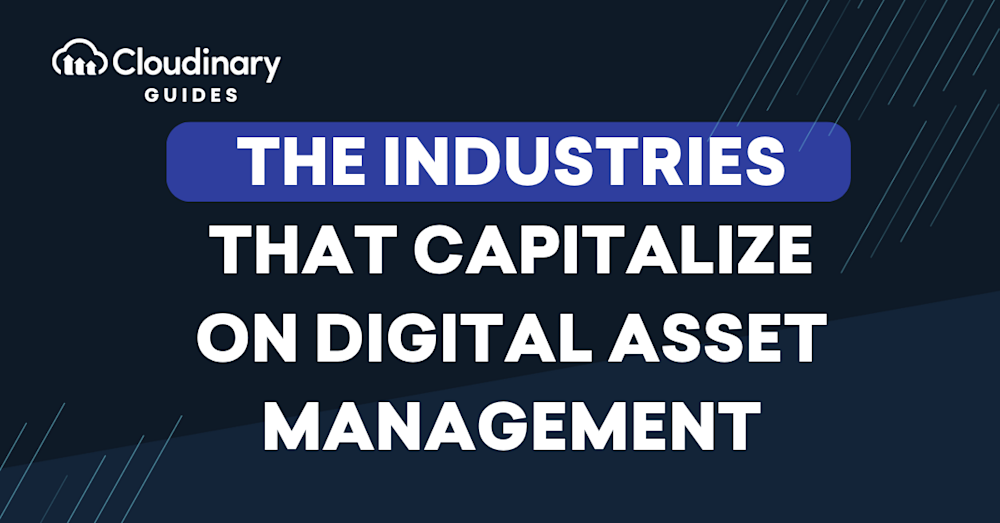Today, businesses must manage an endless volume of media assets: logos, head shots, product and editorial photos, raw footage and short video clips, social-media posts, elements for marketing campaigns. Keeping them all organized and easily referenceable can be a Herculean feat, never mind the numerous versions for use across digital channels. Hence, many organizations turn to technology for help in streamlining it all.
As marketing has evolved over the past decades, so have the needs for managing media assets, notably images and videos, requiring technology for storage or, even more important, for dynamic optimization. All online businesses are prime candidates for leveraging a digital asset management (DAM) solution, but which ones are the most likely to use and benefit from it? That’s the topic of this post.
What is Digital Asset Management?
Digital asset management (DAM) is a systematic approach and software solution designed to store, organize, manage, retrieve, and distribute an organization’s digital assets efficiently. These digital assets include documents, images, audio files, video content, animations, media files, graphics, and presentations—essentially any digital media with inherent value, searchable metadata, and defined access and usage rights.
DAM functions as both a business process and an advanced information management technology, often delivered through a digital asset management system that provides a centralized repository for easy access and management of media assets. This centralization is particularly beneficial for sales and marketing organizations, as it helps streamline asset management, optimize the production of rich media, and maintain brand consistency through automatic asset updates and reinforced brand guidelines, creating a single source of truth within businesses.
Digital Asset Management Industry
E-commerce and Retail
To engage shoppers and heighten the likelihood of their clicking Add to Cart, e-commerce retailers bring products to life with visual media. Those retailers must offer an alternative yet immersive experience that mimics in-store shopping. Online shoppers cannot physically rub fabric between their fingers to feel its texture or pick up a saucepan to inspect it from a different angle. They can, however, zoom in on a high-resolution photo, examine an item with a 360-degree product viewer, or watch a video of the item.
Beyond magazine-quality photo shoots and other branded visual content, e-commerce retailers are also leveraging user-generated content (UGC) site wide, most often on product pages. Besides bringing an authentic human element to the brand, UGC affords relatability that can further influence purchases. In addition, many retail brands offer personalization capabilities through visual media, which, however, require a complex asset-management process that covers all customer segments.
In particular, DAM for e-commerce can support A/B testing, which highlights how visual transformations affect performance and conversions.
Here are two remarkable stories of retailers who are leveraging modern DAMs:
- A sports-equipment retailer adopted 17 (!) storage solutions for its assets before moving to a single DAM platform and centralizing all its images, eliminating workflow inefficiencies and manual transformations. Subsequently, the brand rapidly and smoothly launched a new website in eight countries and can now fulfill ongoing image-related needs in seconds, not weeks as before.
- During a website revamp—over the holidays, no less—a retailer’s teams were manually managing and editing more than 10,000 product images. By embracing a holistic DAM to optimize and transform imagery, the retailer immediately saw shorter page-load times, which were credited as a key contributor to a successful Black Friday and Cyber Monday.
Pro Tip
Consider Cloudinary’s Digital Asset Management
Looking for a centralized location to manage all your media assets? Cloudinary’s Media Library makes it easy to upload, store, manage, and deliver images and videos efficiently.
Media and Entertainment
Whether as a breaking-news source, a publisher, or a content-sharing community, media and entertainment websites invariably find DAMs to be useful for storytelling. It’s easy to see why: The information conveyed on these sites along with the related visuals are constantly changing and, to hold readers’ attention, being able to implement those changes fast is paramount. In short, those organizations must publish content fast. DAMs that leverage AI to automate and optimize asset transformations like cropping and resizing serve that need well, causing visual stories to load fast and look spectacular.
For news organizations that constantly churn out story after story, an easily referenceable media library is important, especially through a DAM with auto-tagging, structured metadata, and quick-search capabilities. Another unique requirement of the media and entertainment arena is that of growing ad revenue, underscoring the need for a centralized system for asset management. For sites that attract millions or billions of monthly views, the content must be fresh, relevant, and optimized for high performance.
One of my favorite DAM examples for this industry, featured prominently on the Cloudinary site, is Bleacher Report (BR), the open-source sports network that boasts 250 million viewers. Before adopting a digital-first DAM, BR had to manually transcode and optimize video highlights for streaming, creating numerous versions afterward for all viewing devices and connectivity speeds. Given its crucial need to provide sports highlights in near-real-time, BR embraced automation for the lifecycle of video management. Now, with a modern DAM in its content-producing arsenal, BR has seen video views jump by 25% and gamecast views surge by more than 350%.
Travel and Hospitality
After the ups and downs of the COVID-19 pandemic, we all could use a long, carefree vacation. A news story from 2020 suggested that simply planning a hypothetical trip, no matter whether you could actually travel to that destination for real, was enough to boost mental health and happiness. Makes sense to me! It also makes sense that travel, tourism, and hospitality brands would earn the benefits of modern DAMs: more conversions through optimization of visuals that promote a destination.
DAM usage in travel and hospitality helps increase bookings and engage travelers at all points of the planning process. Personally, I’m more likely to make reservations at a restaurant if I can get a feel of its ambiance beforehand, or book a room at a certain hotel over another based on the visuals of the amenities.
Similar to e-commerce, travelers enjoy reading reviews from past guests and other UGC created by fellow travelers, for all those posts generate a sense of trust that what they see online will be the same as what they experience in person. DAMs optimize UGC, too, automatically ensuring consistency, proper sizing, cropping, compression, and optimal formats.
Nonprofits
As the last industry explored in this post, nonprofits are certainly not the last industry with the potential to leverage DAMs. Because nonprofits must engage with distinct audiences and donor communities, that industry must deliver engaging digital experiences in the same way as for-profit companies, but with far less resources.
To me, emotion plays into digital content for nonprofits far more than for other industries. For nonprofits, establishing a connection to a cause or social issue is paramount to their existence. With DAMs, nonprofits are freed of the logistical hurdles that accompany manual asset management, focusing instead on creating online experiences that help further the mission.
DAM-Afforded Agility for All Industries
In today’s digital economy, no matter the industry or intended audience, DAMs must be digital-first, built specifically to meet the digital demands businesses face. Regardless of the business type, modern and digital-first DAMs help deliver more captivating experiences faster and at scale with an agility that facilitates pivots as necessary when digital needs change.
To learn more about DAM and the considerations for adopting it, check out our eBook, Digital-First Brand Experiences Require a Digital-First DAM, which details the centralized support afforded by digital-first DAMs: one version of the truth. The book also cites real-world examples of how, through DAMs, connected and compressed work streams foster collaboration and creativity for competitiveness and how agility can bolster business growth. Do have a look.

